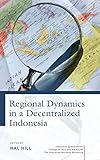Regional Dynamics in a Decentralized Indonesia / ed. by Hal Hill.
Material type: TextPublisher: Singapore : ISEAS Publishing, [2014]Copyright date: 2014Description: 1 online resource (566 p.)Content type:
TextPublisher: Singapore : ISEAS Publishing, [2014]Copyright date: 2014Description: 1 online resource (566 p.)Content type: - 9789814459853
- 9789814519175
- online - DeGruyter
| Item type | Current library | Call number | URL | Status | Notes | Barcode | |
|---|---|---|---|---|---|---|---|
 eBook
eBook
|
Biblioteca "Angelicum" Pont. Univ. S.Tommaso d'Aquino Nuvola online | online - DeGruyter (Browse shelf(Opens below)) | Online access | Not for loan (Accesso limitato) | Accesso per gli utenti autorizzati / Access for authorized users | (dgr)9789814519175 |
Frontmatter -- In memory of Dr Thee Kian Wie -- Contents -- Tables -- Figures -- Contributors -- Acknowledgments -- Glossary -- Map of Indonesia -- 1. An introduction to the issues -- PART 1. Historical, economic, political and social patterns -- 2. Before the ‘big bang’: decentralization debates and practice in Indonesia, 1949–99 -- 3. Indonesia’s decentralization: the rise of local identities and the survival of the nation-state -- 4. Hares and tortoises: regional development dynamics in Indonesia -- 5. Patterns of regional poverty in the new Indonesia -- PART 2. Decentralization and governance -- 6. Twelve years of fiscal decentralization: a balance sheet -- 7. Local governance and development outcomes -- 8. Decentralization, governance and public service delivery -- 9. What determines the quality of subnational economic governance? Comparing Indonesia and Vietnam -- PART 3. Local-level perspectives -- 10. Dilemmas of participation: the National Community Empowerment Program -- 11. Governing fragile ecologies: a perspective on forest and land-based development in the regions -- 12. Explaining regional heterogeneity of poverty: evidence from a decentralized Indonesia -- PART 4. Migration, cities and connectivity -- 13. Migration patterns: people on the move -- 14. Regional labour markets in 2002–12: limited convergence but integration nonetheless -- 15. The dynamics of Jabodetabek development: the challenge of urban governance -- 16. Challenges of implementing logistics reform in Indonesia -- PART 5. Challenges for Indonesia’s periphery -- 17. The political impact of carving up Papua -- 18. Development in Papua after special autonomy -- 19. Special autonomy, predatory peace and the resolution of the Aceh conflict -- 20. Aceh’s economy: prospects for revival after disaster and war -- Author index -- Subject index
restricted access online access with authorization star
http://purl.org/coar/access_right/c_16ec
Indonesia is the world’s largest archipelagic state. In 2001 it embarked on a “big bang” decentralization involving a major transfer of administrative, political and financial authority to its districts, now numbering more than 500. Together with the rapid transition from authoritarian to democratic rule in the late 1990s, this initiative has transformed the country’s political, social and business life. While national government is the major area of contestation, power has shifted irreversibly away from the centre. How this significantly increased regional autonomy works will have a crucial bearing on the future of the Indonesian nation-state. This volume features contributions by over 40 writers with deep expertise on Indonesia. The book provides a timely, comprehensive and analytical assessment of the country’s regional development dynamics in the post-decentralization environment. It explores historical, political and development patterns at the regional level; the relationship between decentralization and governance; local-level perspectives; migration, cities and connectivity; and the challenges confronting the peripheral regions of Aceh and Papua.
Mode of access: Internet via World Wide Web.
In English.
Description based on online resource; title from PDF title page (publisher's Web site, viewed 26. Aug 2024)


